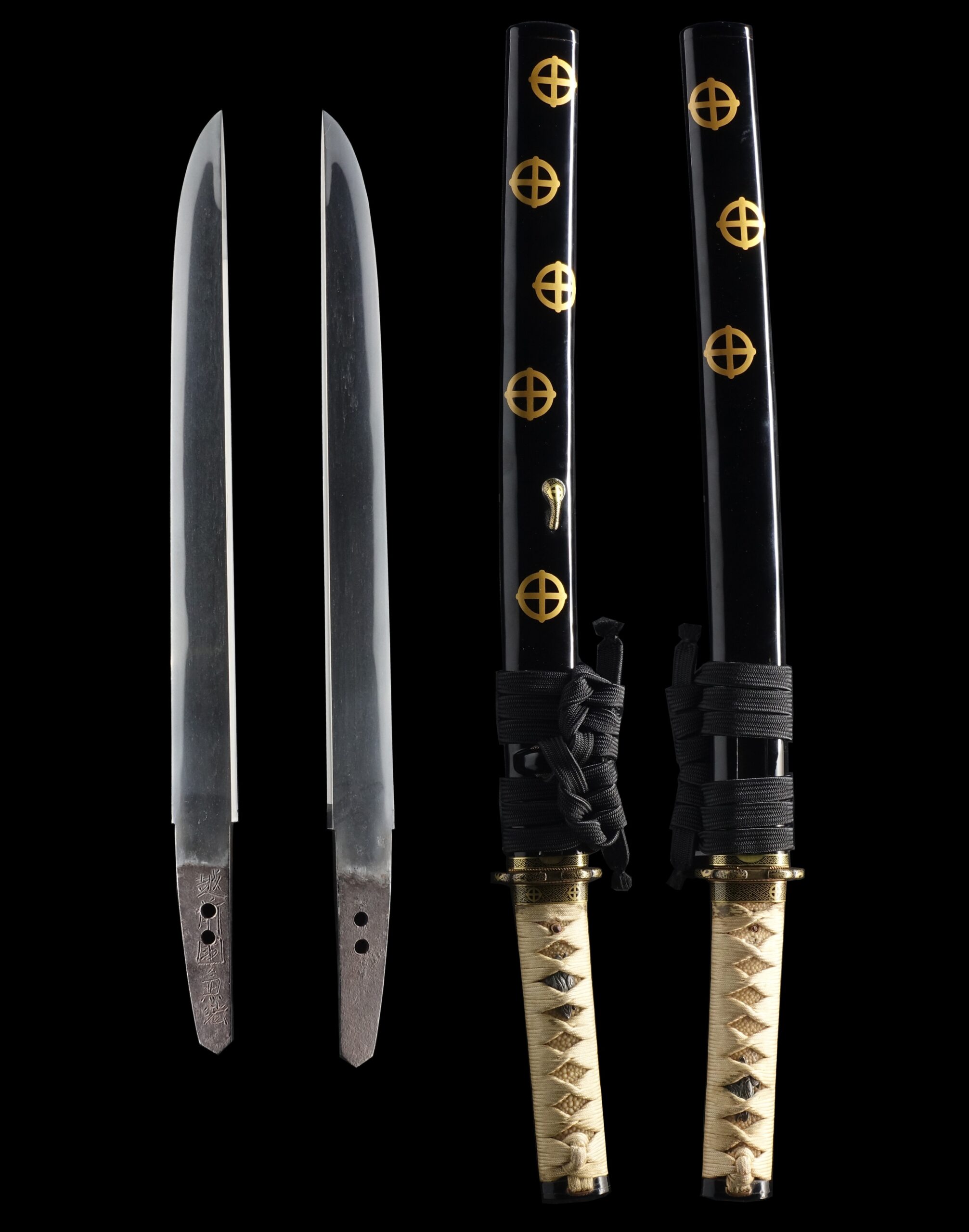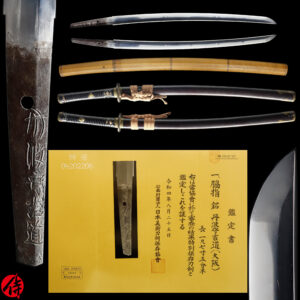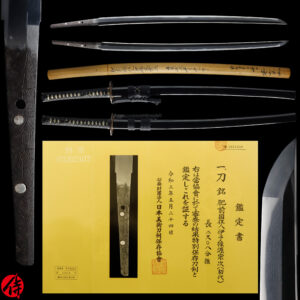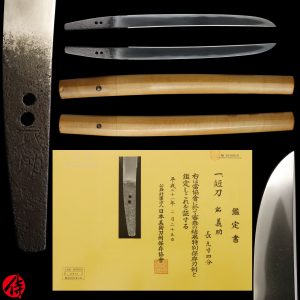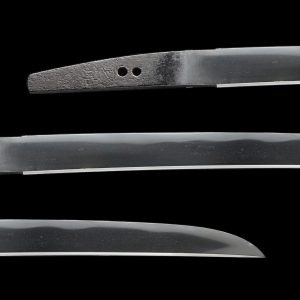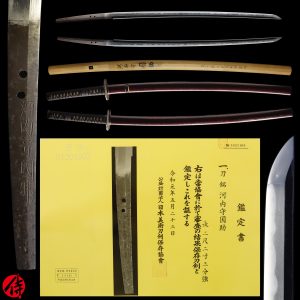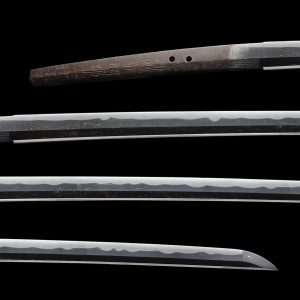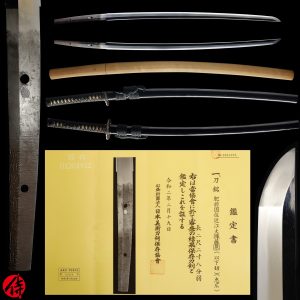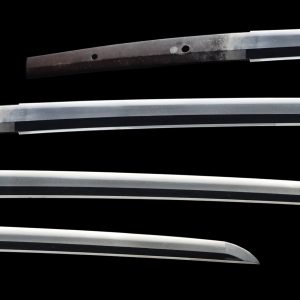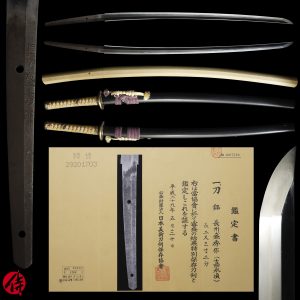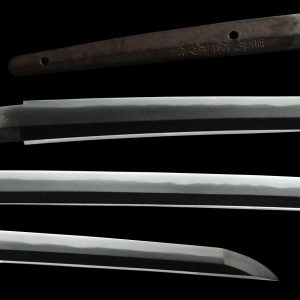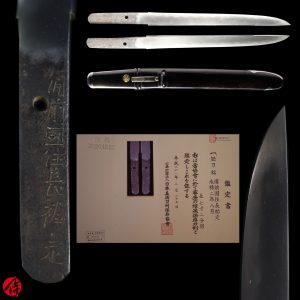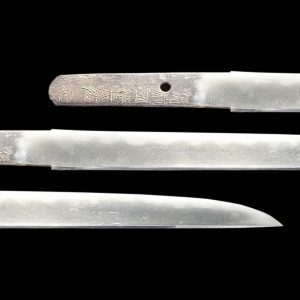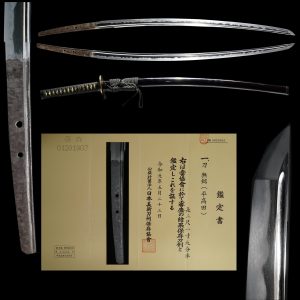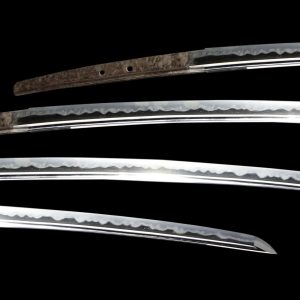Antique Japanese Sword Tanto Signed by Kanenori with Tokubetsu Hozon Certificate
【Description】
This blade was signed by Echizen Koku Kanenori (越前国兼法) during the early Edo period. Echizen Koku is the name of the province located in today’s Fukui prefecture. He resided in this area when he forged this blade. The maker’s name, Kanenori lasted a few generations and we believe it was made by a late-gen Kanenori.
The first-gen Kanenori was originally from Mino province (today’s Gifu prefecture) and belonged to Nara school, whose headquarters was Akasaka Senjuin school. Akasaka Senjuin school was located in Akasaka village near Sekigahara, an essential hub for transportation and military bases from ancient times. It is said that the Akasaka Senjuin school was founded by Sensui (泉水), the son of Yamato Koku Senjuin Shigehiro. Yamato region was one of the most famous sites for sword-forging during the late Heian-Kamakura period. Sensui moved from Yamato (today’s Nara prefecture) to Akasaka village in Mino province during the Nanbokucho period (early 14th century). The earliest work of the first-gen Kanenori is from the 8th year of the Meio era (1500).
It was the 4th-gen Kanenori that moved from Mino province to Echizen province during the Tensho era (1573-1592) by being invited by Yuki (結城) clan. And, Kanenori founded his school and trained many apprentices. Echizen province was prosperous during the Edo period, being ruled by the Echizen Matsudaira clan, a direct retainer of the Tokugawa clan who ruled the Edo government. Many skilled swordsmiths moved to Echizen from different regions because of the high demand among Samurai. Many renowned swordsmiths were originally from the Mino province (Gifu prefecture). They are called Echizen Seki swordsmiths.
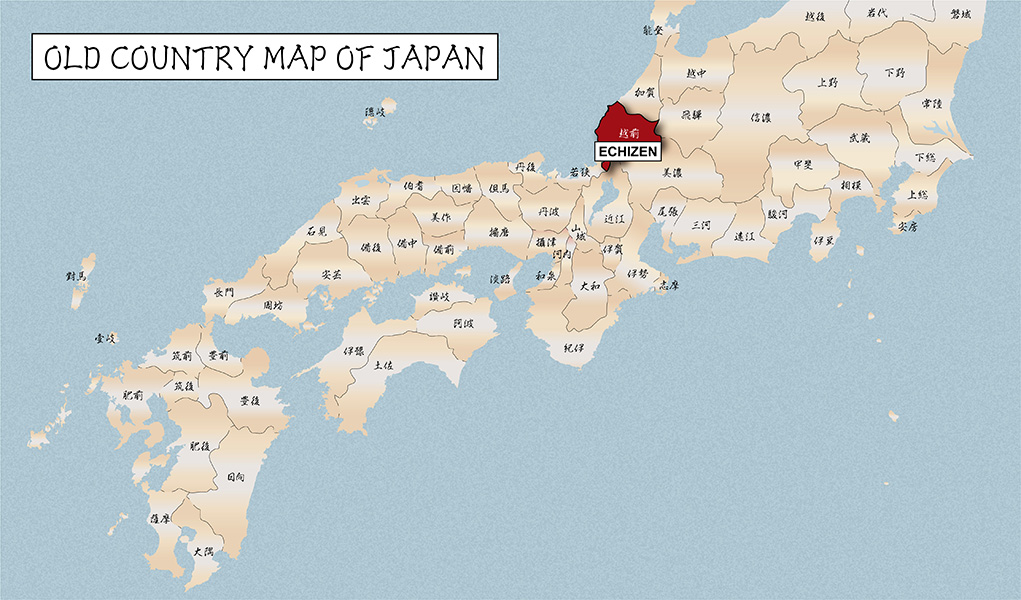
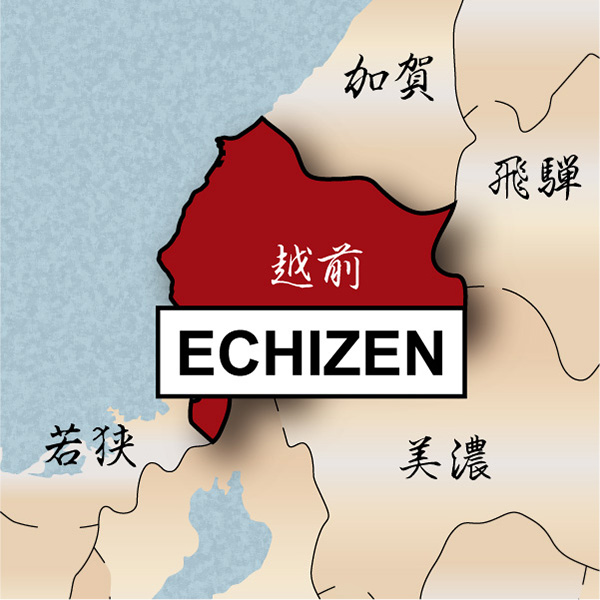
This blade is appraised as a Tokubetsu Hozon Token(特別保存刀剣) issued by NBTHK(Nihon Bijutsu Touken Hozon Kyokai:日本美術刀剣保存協会). This authentication paper was only given to authentic Japanese swords, especially well preserved and high quality with artistic value.
*Please keep in mind that while the blade is Tanto, it comes with a Wakizashi size Koshirae.
【 Blade】
Cutting Edge Length(Nagasa):29.5 cm (11.6 inches)
Curvature(Sori): 0.0 cm (0.0 inches)


Hamon:
The crystalline structure which forms along the cutting edge of a blade as a result of the hardening process
Jimon(Jihada):
visible steel surface pattern created by folding and hammering during forging process
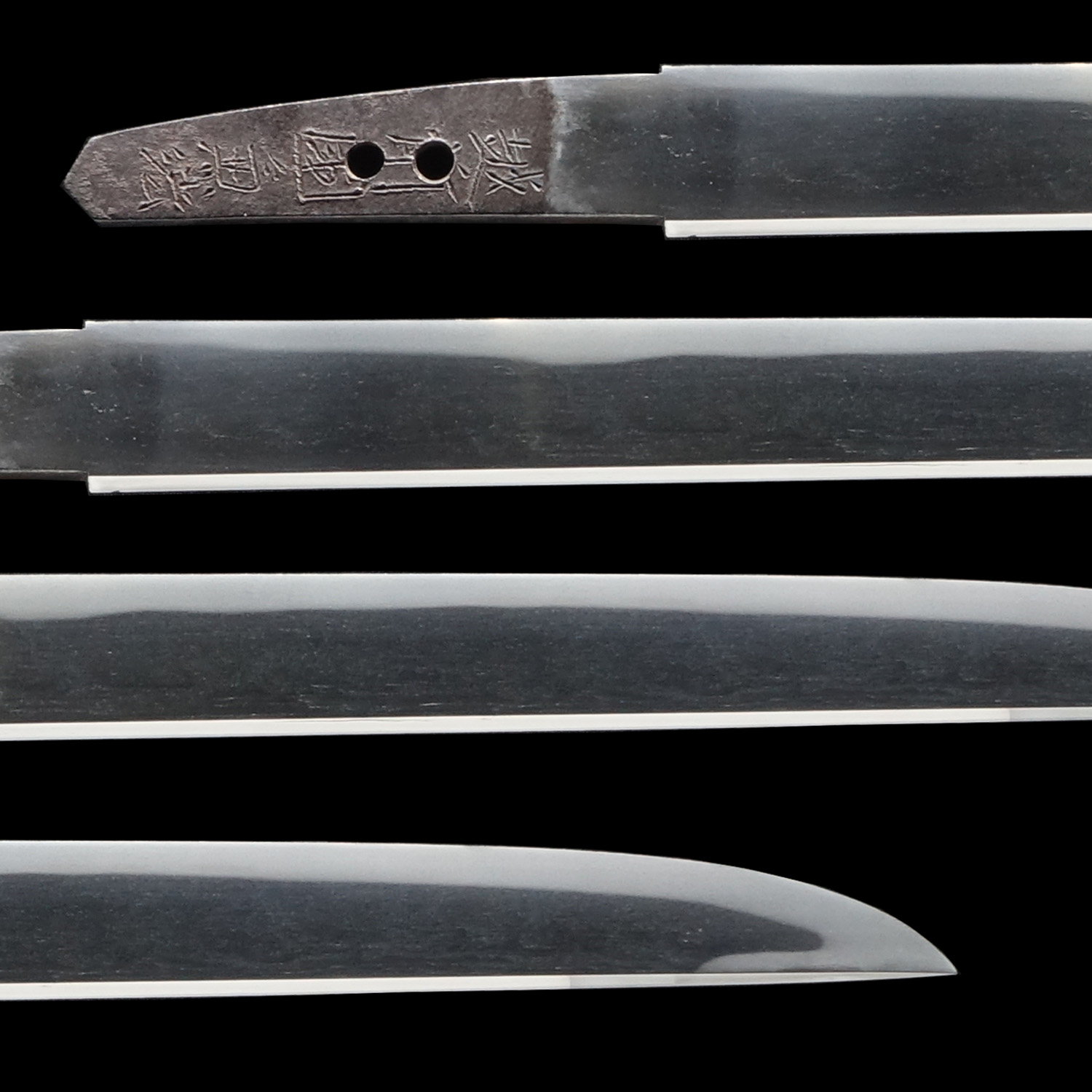
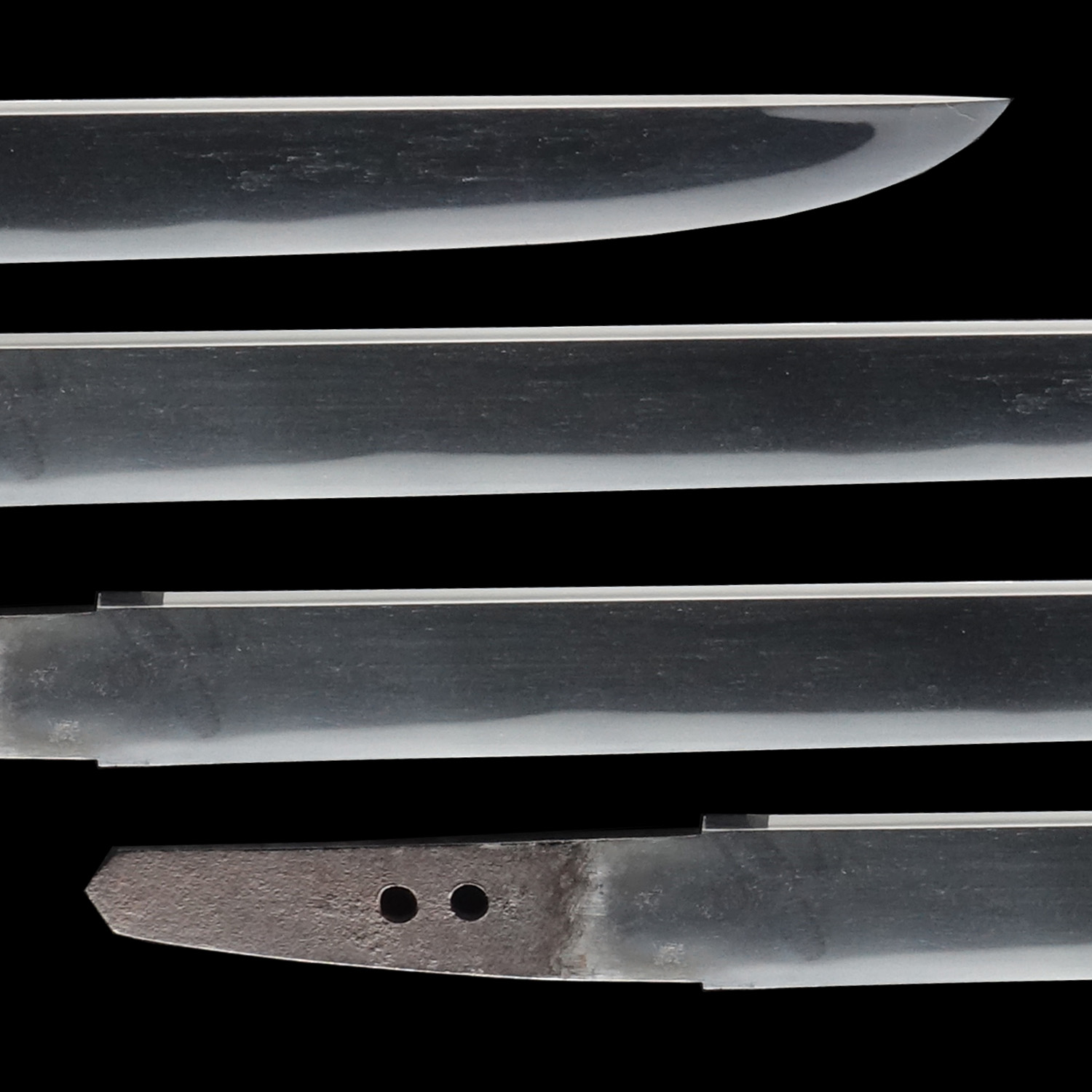


Nakago:Nakago is the tang of the Japanese sword.
Japanese swordsmiths left the black rust on the tang because it prevents red rust while the tang is in its handle. And the discoloration of the tang was created over time, and it is a great indicator for a Japanese sword specialist to estimate when the sword was forged.

Koshirae: Koshirae is the mounting of the Japanese sword. There are several parts that consist of Koshirae such as Saya(Scabbard), Tsuka( Handle), Tsuba(Handguard).

Fuchi-Kashira:A pair of matching sword fittings that cover the upper and bottom parts of its sword hilt.
The same motifs of overlapping crosse in a circle are depicted on this Fuchi Kashira. We estimate these patterns are designed here as family crests. There is a famous family crest that looks a little different but is very similar to these: Maru-ni Juji Mon (丸に十字紋). This crest was used by the Shimazu Daimyo family, based in Satsuma (薩摩, the west side of Kagoshima prefecture today) from the Kamakura period (1185-1333) to the Edo period. There are several theories about the origin of this design. Firstly, it is said that this pattern symbolizes the figure of two dragons. Secondly, its origin is the charm of crossing two chopsticks to win the battles. Another theory says it comes from a spell in the form of “cutting a cross.” People once believed this action would protect them from misfortune and bring good luck. Therefore, it is thought that the Maru-ni Juji Mon has been regarded as a good omen motif and started to be used for family crests.
While we are unsure whether the former owner of this Tanto was a person related to the Shimazu family, we could imagine that there might have been a connection somewhere.

Tsuka and Menuki:Tsuka is the handle of the Japanese sword and Menuki is its decoration.
Although we cannot see its entire shape, we estimate the principal motif of this Menuki is a kind of bird. Seeing from the gaps of the Tsukamaki thread, we think it depicts a sideways bird surrounded by clouds or wave patterns. The color of the metal surface changes due to aging. However, it is a trace of the long history it passed, so we hope you would enjoy it as an antique texture.
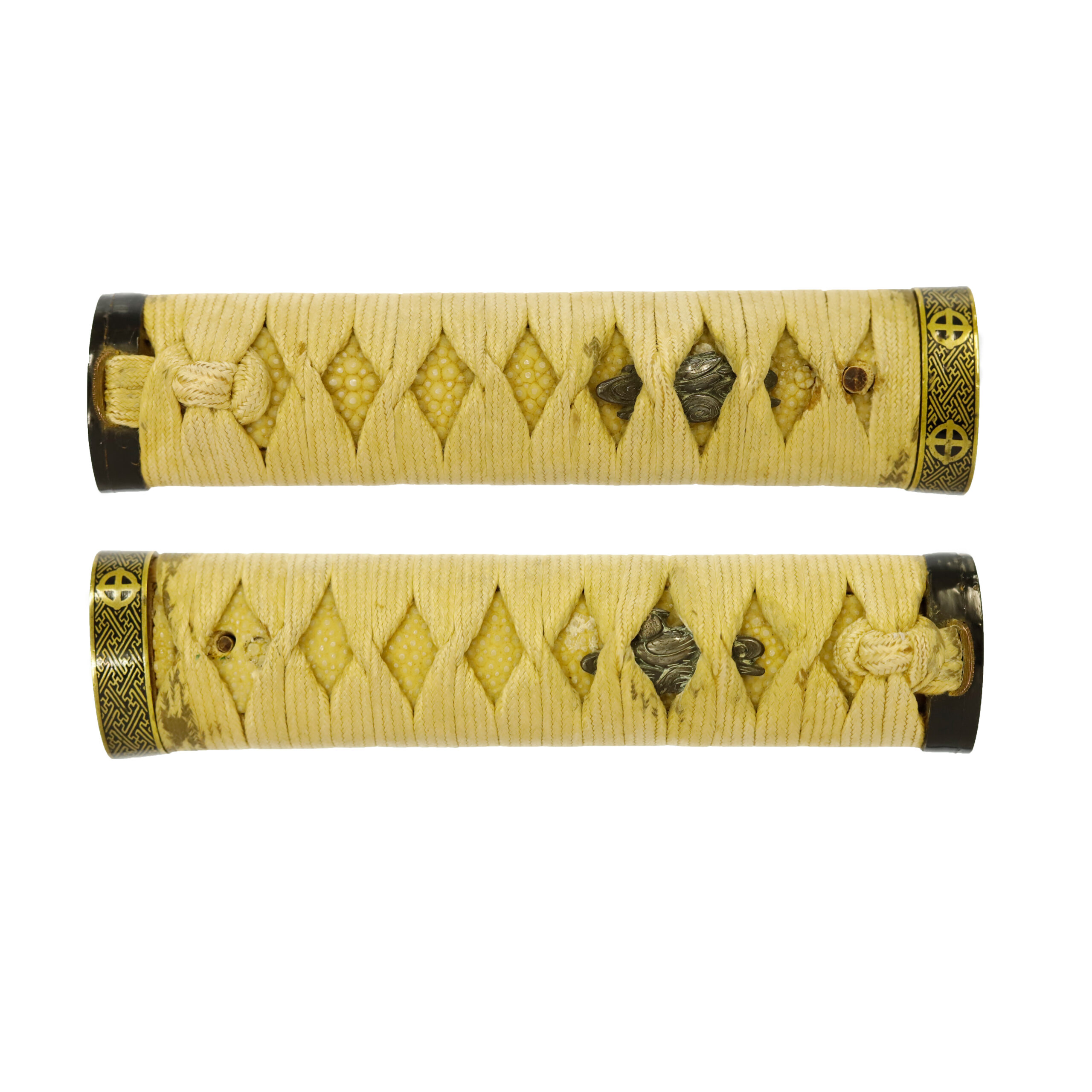

Tsuba and Habaki:Tsuba is the handguard for the Japanese Sword and Habaki is the equipment to make the blade not touch its scabbard inside. It prevents the blade from getting rusty and chipped.
This Tsuba has the same design as the Fuchi part mentioned above. You remember the Maru-ni Juji Mon, and the entire surface is decorated with geometric patterns that combine straight lines. This pattern is called the Saya Gata (紗綾形) pattern. It is a type of continuous design, and many Samurai appreciated it. According to a theory, this motif was brought from a foreign country to Japan in the Momoyama period (1568-1600). The Saya Gata pattern has a graceful appearance and represents the longevity and prosperity of the family. Its golden lines make an elegant color contrast with the metal’s black color on this work.

Saya: Saya is the scabbard for the Japanese sword.
*Please keep in mind that the Saya is relatively long one for the Tanto.
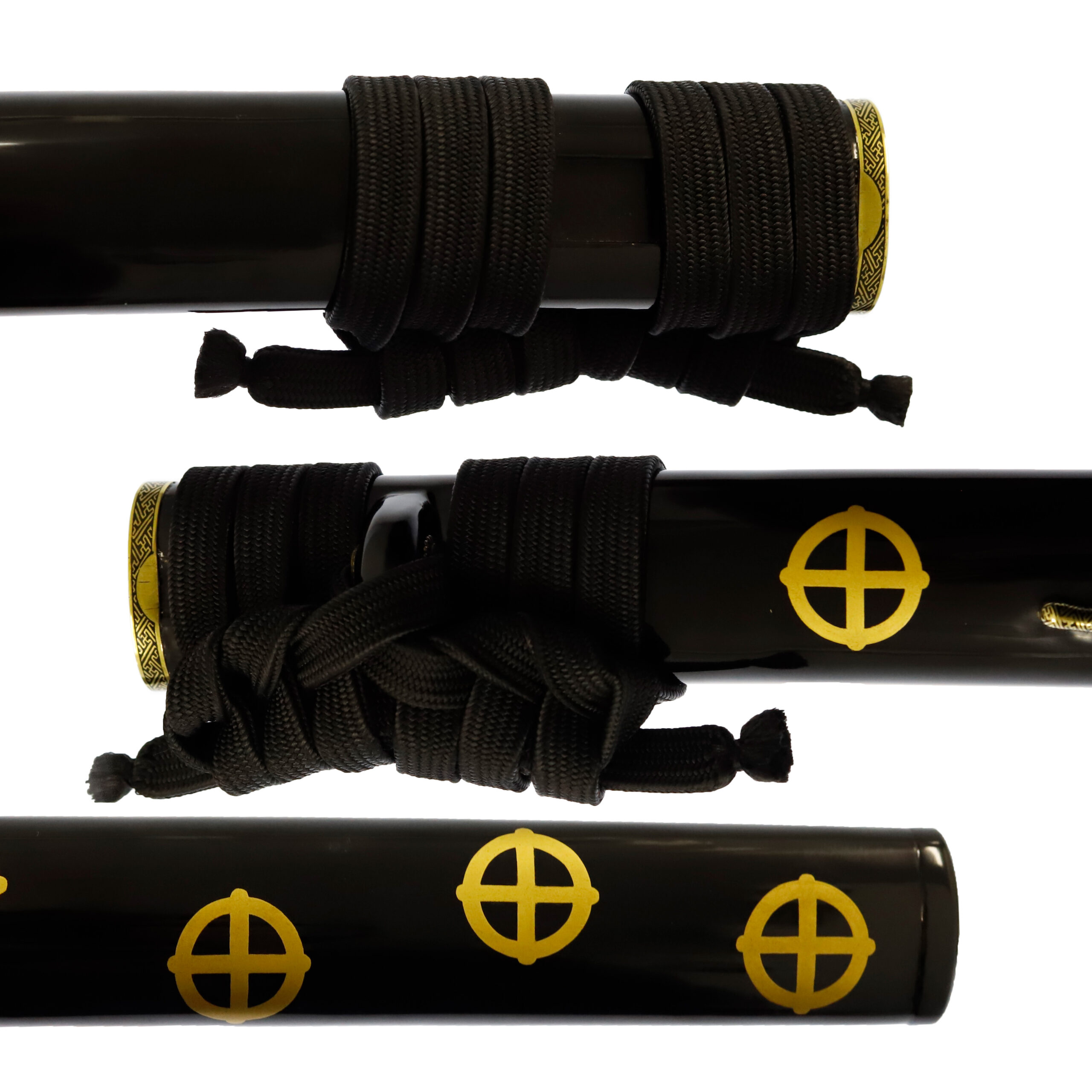
Authentication Paper:NBTHK TOKUBETSU Hozon Certificate for the blade (No. 1013027)
NBTHK, also known as Nihon Bijutsu Touken Hozon Kyokai (the Society for the Preservation of the Japan Art Sword), is one of the oldest Japanese sword appraising organizations in modern-day Japan. They authenticated the blade on Feb 19th in the 2nd year of Reiwa (2020). They appraised it as Tokubetsu Hozon Touken, the blade especially worth preserving for Japanese society. The purchaser will receive this original certificate as well. We can also translate what is written into English and make a PDF file for your record if you request.

Registration Number : Okayama 86398
The Board of Education in Okayama prefecture issued a registration paper for this sword . It is called Jyu Token Rui Torokusho(銃刀剣類登録証). Bunkacho(The Agency for Cultural Affairs) acknowledges a Japanese sword with this paper as a work of art.
The sword needs to be traditionally hand-forged and made of Tamahagane carbon steel to be registered in the system. With this paper, its owner in Japan can legally own an authentic Japanese sword. Based on this registration number, we will apply for its export permit.
This paper will need to be returned to the board of education when the sword is being shipped abroad, but you can receive a copy of it. An English translation of this registration paper is available on request.


—————————————————————–
【About us】
Samurai Museum is located in Tokyo, Japan, exhibiting antique artifacts related to the Samurai history. Samurai Museum Shop is the place for those who are interested in Japanese culture and craftsmanship. We deal with antique Samurai swords/armor, traditional crafts made in Japan and so on.
【Japanese Sword& Export Process】
The Japanese swords we deal with are hand-forged edged swords made in Japan. It was made from the traditional carbon steel called TAMAHAGANE(玉鋼). Samurai Museum is familiar with the proper legal procedure for an antique/ authentic Japanese sword to be exported from Japan. We have sent more than 500 Japanese swords for the past three years (~2023) to amazing owners who appreciate its historical value.
Each Japanese sword is registered under the Agency for Cultural Affairs and the Board of Education in Japan. They issue a registration paper for each Japanese sword for its owner in Japan to legally possess it. The Japanese sword with its registration paper means it was traditionally hand-forged in Japan.
To legally export the sword from Japan to other countries, we will have to apply for its permit to the Agency for Cultural Affairs(Bunkacho) and return the original registration paper to the Board of Education. It normally takes around 2-4 weeks to receive this permit after submitting required documents. And we would like you to expect at least 1-1.5 months for your order to arrive at your given address after you ordered. For more detailed info, please click here.
It is allowed for residents in Japan to own authentic Japanese swords without a special license as long as they come with registration papers. Please feel free to contact us if you are a resident of Japan, whether temporarily or permanently. We will also assist you when you leave Japan and need to obtain the export permit.
【Payment Method】
We accept payment through Stripe (Credit card), PayPal, Apple Pay or ChromePay, all of which are secure payment methods. Also, you don’t need to make an account on Stripe for the checkout. If you prefer other payment method, please contact us. After confirming your payment, we will apply for an export permit. You may either pay in JPY, USD, AUD, CAD,EUR CHF or GBP. The price is set in Japanese Yen. Prices in other currencies are automatically calculated based on the latest exchange rate.

* If the amount is above 1 million JPY, Stripe or wire transfer will be the only options for payment.
【Shipping】
We have shipped authentic Japanese swords to the USA, UK, Canada, Mexico, Germany, Switzerland, France, Hong Kong, Finland and Australia. If you don’t live in these countries and like to order, please contact us first before making a purchase. We offer Free International Shipping as long as we can send antique Japanese swords by EMS.
We normally ship by EMS(Express Mail Service) provided by Japan Post. We will send you a tracking number for your order as soon as we hand it to the post office. We will put 100 % insurance on the shipping document without any extra charge. Based on the total amount, there might be a duty tax or other fee for you to pay, depending on the countries. We use package cushioning to protect the item and put it in a PVC pipe, which is one of the most secure packages because of its durability.
It will normally takes 5-14 days for the item to arrive at your given address after we dispatch it. Time of delivery is estimated as accurately as possible by the carrier but does not take into account any delays beyond our control such as by inclement weather, post office holiday seasons.
* If you live in Australia and like to purchase an authentic Japanese sword, please click here to know the detail.
*Please keep in mind that due to the spread of COVID-19, there might be delays in shipping. If you like to know the detail about shipping, please feel free to ask us.

【Review】
Here is one of the reviews we received from a customer who purchased an authentic Japanese sword from us. For more reviews, please click here.
“My experience overall with the whole process was wonderful. I had many questions about the history and process to purchase these treasures. All my questions were answered very timely and complete. The staff is very knowledgeable and very well versed if any questions do arise.”
【How to make sure the condition】
Please keep in mind that what you are going to purchase is an antique item. We uploaded high resolution photos for you to check its condition thoroughly. If you like to see more photos with different angles, please feel free to contact us. We will be happy to send them to you so that you can make informed decision. It is essential for us to know that you are happy with your choice of a sword. and we are prepared to use the best of our ability to serve you.
【How To Contact Us】
Please contact us through email, Facebook Messenger or Live Chat if you have any questions. You can find each icon on the right side of the website. Please click one of them to reach us. We will reply to you within 1-2 business days.
【The Art of Nihonto (Japanese Sword)】
Samurai’s history is a profound, eloquent legacy of ancient Japanese warriors in which millions of people worldwide are being fascinated. If you like to find out the art of Nihonto, please click here.
【A Guide to Japanese Sword Maintenance】
After acquiring an genuine Japanese sword, it is also important to know how to take good care of it. Here is the special video for you. Mr. Paul Martin, Japanese sword expert, shows you how to give proper maintenance to your sword. By mastering how to clean the Japanese sword, its aesthetic beauty will last forever.
When you purchase a Japanese sword from us, you can get a Free Japanese sword maintenance kit. It comes with four tools(Choji Oil, Uchiko Whetstone Powder, Peg remover, Oil Applicator). By watching the video instruction above , you can enjoy learning how to maintain your Japanese sword while appreciating it. If you have any difficulty assembling the sword or cleaning the blade, you can feel free to contact us.


MORE ANTIQUE JAPANESE SWORD FOR SALE
SWORDS WITHOUT CERTIFICATES FOR SALE
LEARN JAPANESE SWORD TERMINOLOGY
Thank you for reading all the information on the page. If you have any difficulty choosing the right Japanese sword for you, we will be more than happy to help you find the one that speaks to you the most. Please feel free to contact us.

